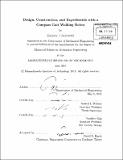Design, construction, and experiments with a compass gait walking robot
Author(s)
Jackowski, Zachary John
DownloadFull printable version (12.59Mb)
Other Contributors
Massachusetts Institute of Technology. Dept. of Mechanical Engineering.
Advisor
Russell L Tedrake.
Terms of use
Metadata
Show full item recordAbstract
In recent years a number of new computational techniques for the control of nonlinear and underactuated systems have been developed and tested largely in theory and simulation. In order to better understand how these new tools are applied to real systems and to expose areas where the theory is lacking testing on a physical model system is necessary. In this thesis a human scale, free walking, planar bipedal walking robot is designed and several of these new control techniques are tested. These include system identification via simulation error optimization, simulation based LQR-Trees, and transverse stabilization of trajectories. Emphasis is put on the topics of designing highly dynamic robots, practical considerations in implementation of these advanced control strategies, and exploring where these techniques need additional development.
Description
Thesis (S.M.)--Massachusetts Institute of Technology, Dept. of Mechanical Engineering, 2011. Cataloged from PDF version of thesis. Includes bibliographical references (p. 91-93).
Date issued
2011Department
Massachusetts Institute of Technology. Department of Mechanical EngineeringPublisher
Massachusetts Institute of Technology
Keywords
Mechanical Engineering.